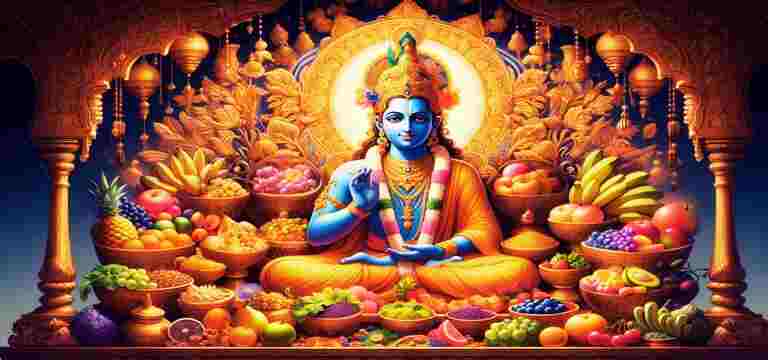Have you noticed how your food affects your body and mind? After a healthy, nourishing meal, you often feel energetic and happy. On the other hand, heavy or unhealthy diet can leave you sluggish or even a bit gloomy. It’s not just flavour or nutrients at work—it’s how food subtly influences your inner nature.
Long before modern nutrition science existed, our ancestors recognised this connection. In the Bhagavad Gita—one of the cornerstones of Indian wisdom—Lord Krishna groups diet into three types (sattvic, rajasic, and tamasic) based on how they affect our temperament and energy. Sattvic diet promote calmness and clarity, rajasic diet bring activity and restlessness, and tamasic diet tend to dull the body and mind.
Today, with so many ultra-processed foods around, these ancient insights remain more relevant than ever. By understanding how different items interact with our mental and spiritual well-being, we can choose what nourishes us—body, mind, and soul. Let’s discover timeless wisdom and learn to choose foods that promote a balanced, healthy life.
The Food Influence and the Three Gunas (Qualities)
In Chapter 17 of the Bhagavad Gita, Lord Krishna describes how everything we do—our faith, actions, our giving—falls into three categories: sattvic, rajasic, and tamasic. He uses the same three-fold idea to explain diet, showing how what we eat affects our nature, thoughts, and behaviour.
- Sattva (Purity & Light):
- Brings calm, balance, clarity, and positivity.
- Foods that are fresh, light, and nourishing (like fruits, vegetables, whole grains) increase sattva in us, making us peaceful and clear-headed.
- Rajas (Activity & Restlessness):
- It brings stress and dissatisfaction.
- Items that are spicy, stimulating, or very flavorful (like coffee, fried snacks, rich sauces) boost rajas, making us active but sometimes anxious or restless.
- Tamas (Inertia & Darkness):
- Brings dullness, laziness, ignorance, and destructive tendencies.
- Items that are over-processed, stale, or heavy (like packaged junk food, leftover deep-fried items) feed tamas, leaving us lethargic, foggy, or negative.
Key Point:
Whichever food you eat most will strengthen the matching quality in you.
- Eat more sattvic diet → you feel calm and clear.
- Eat more rajasic diet → You feel driven but may get tense.
- Eat more tamasic diet → you feel sluggish and low.
Over time, these influences affect your thoughts, emotions, health, and overall quality of life. Choosing mostly sattvic diet helps keep your body, mind, and spirit in harmony.
Sattvic Food:
According to the Bhagavad Gita (Chapter 17, Verse 8), Sattvic diet is nourishing, pure, and naturally satisfying. This type of diet promotes longevity, inner strength, health, happiness, and contentment. It is characterised by its juiciness, smooth texture, and wholesome nature, providing profound nourishment for both body and mind.
Key Features of Sattvic Diet:
- Fresh and Pure: Crafted from natural ingredients, free from preservatives and artificial additives.
- Easy to Digest: Light on the stomach, leaving you feeling energised rather than sluggish.
- Nourishing: Naturally sweet or juicy, offering genuine nourishment.
- Prepared with Positive Intentions: Cooked with love and care, enhancing their healing properties.
- Mental Calmness: Consuming these items fosters a peaceful and clear mind.
In short, opting for Sattvic diet—such as fresh fruits, vegetables, whole grains, and mild spices—nurtures your body, mind, and spirit, promoting a sense of health, peace, and happiness.
Rajasic Food:
The Bhagavad Gita explains that Rajasic food (like spicy, fried, or overly salty meals) gives you a quick burst of energy and makes you feel active and ambitious. But this energy is unstable—it’s like a sugar rush! While it pumps you up at first, it soon leaves your mind restless, your cravings stronger, and your body struggling to digest it. Imagine feeling hyper but also irritable, or wanting more even when you’re full—that’s Rajasic diet messing with your balance.
Key Features of Rajasic Diet:
- Overpowering flavours: Excessively spicy, sour, salty, or overly sweet.
- Contains stimulants: Like tea, coffee, or energy drinks that hype you up temporarily.
- Oily and spicy: Fried snacks, heavily spiced dishes, or greasy fast food.
- Overstimulates the mind and body: Makes you restless or hyperactive if eaten too much.
- Causes pain and diseases: Regular consumption leads to digestive issues, acidity, high blood pressure, or heart problems.
Eating too much Rajasic meal makes your mind restless and increases anger, worry, and stress. It also heats your body and can cause stomach problems like indigestion. In today’s fast-paced life, people often rely on Rajasic foods, which damage both physical and mental health over time.
tamsic food:
Tamasic diet (the third type in the Bhagavad Gita) creates heaviness and laziness in the body. It makes the mind dull, negative, and inactive. This food is tough to digest and harms the body over time. Examples include stale, rotten, or unclean food (like leftovers kept too long or spoiled meals). Tamasic food drains your energy and clouds your mind.
Tamasic Food in the Modern World:
Today, the Tamasic food described in the Bhagavad Gita refers to ultra-processed foods (UPF) like chips, packaged snacks, or instant meals. These items are not natural or fresh, but are made in factories with chemical additives, artificial flavours, colours, and preservatives to look attractive and last longer.
They’re designed to taste addictive but lack real nutrition. Eating them regularly makes the body sluggish, the mind foggy, and harms long-term health.
Key Features of Tamasic Foods:
- Full of Fake Stuff: Packed with harmful additives like artificial sweeteners (HFCS), trans fats (hydrogenated oils), MSG, fake flavours, and colours. These chemicals are terrible for your body.
- Zero Real Nutrition: Most natural vitamins, minerals, and fibre are destroyed during processing. What’s left is empty calories.
- Sugar, Salt, and Bad Fats Overload: To make them taste good and last longer, they’re loaded with extra sugar, salt, and unhealthy fats (especially trans fats). This combo fuels obesity, diabetes, and heart issues.
- Looks Good, Harms Health: Bright, flashy packaging and addictive taste (especially for kids!) hide the fact that these items are silently damaging health.
- Hard to Digest, Toxic Inside: The artificial junk and bad fats strain your gut, create toxins in the body, and lead to bloating, fatigue, or worse.
Health Risks of Tamasic (Ultra-Processed) Foods:
- Obesity: UPF is high in calories but low in nutrients. It disrupts your natural hunger signals, making you overeat and gain weight.
- Heart Disease: Packed with salt, sugar, and unhealthy fats, UPF raises blood pressure and cholesterol, increasing the risk of heart attacks.
- Diabetes: Loaded with sugary additives (like HFCS), UPF spikes blood sugar levels quickly, leading to insulin resistance and Type 2 diabetes.
- Digestive Issues: Lacks fiber and is full of artificial junk, causing constipation, acidity, and gut problems.
- Liver Damage: Excess sugar and fat overload the liver, leading to fatty liver disease and long-term harm.
Research shows people who eat a lot of ultra-processed foods (UPF) have higher rates of depression and anxiety. UPF lacks nutrients and contains artificial chemicals that harm brain health.
Modern Lifestyle and the Trap of Tamasic Foods:
In today’s fast-paced, busy life, people look for ready-to-eat and quick foods. UPF have emerged to meet this demand. Bright packaging and intense flavors (high in sugar, salt, and fat) make them very appealing. Their easy availability anywhere has made these foods extremely popular.
Globalisation has increased the influence of Western fast-food culture in countries like India. People used to eat homemade, nutritious meals. Today, pizza, burgers, chips, chocolates, and cold drinks have become a regular part of our diet. Unfortunately, most of these foods fall into the tamasic category and are very harmful to health.
Every person needs food, clothing, and shelter. While clothing and shelter have become more comfortable with modern conveniences, changes in our diet are worrying for health. We are moving away from nutritious, traditional, locally available foods and turning to chemically processed items. This shift is like a kind of “blind imitation.”
Returning to Sattvic Food:
The Bhagavad Gita’s wisdom urges us to think about our food choices. We should not pick foods just for taste or convenience. It’s important to consider how and what we eat affects our mind and body. Given the dangers of tamasic (UPF) diet, moving back to sattvic diet is the way to a healthy, balanced life.
How to Adopt a Sattvic Diet?
- Be Mindful: Pay attention to what you eat and how it makes you feel. Notice if it boosts your energy or leaves you sluggish, happy or irritable.
- Choose Fresh & Natural: Choose fresh fruits, veggies, and grains (like apples, spinach, brown rice). Avoid packaged snacks, frozen dinners, and items with lengthy ingredient lists.
- Cook at Home: Avoid eating out or ordering takeaways. Instead, cook simple, nutritious meals at home using less oil and spices. Homemade food is fresher, cleaner, and aligns better with a Sattvic diet.
- Go Traditional: Add nutritive grains like jowar (sorghum), bajra (pearl millet), and nachni (finger millet) to your meals. Focus on traditional veggies and fruits grown locally in your region—they’re healthier and more sustainable!
- Stay Hydrated: Drink plain water. Avoid sugary drinks and sodas.
- Eat Slowly: Focus on your meal. Concentrate on your meal as you eat. Take your time to chew and enjoy your food in a peaceful setting.
- Read Labels: Check ingredients in packaged items. Avoid artificial additives, excess sugar, or salt.
- Start Small: Don’t stress! Gradually replace junk food (Tamasic) with Sattvic options. Progress > perfection!
Key Terms:
- Sattvic = Pure, fresh, natural items (e.g., fruits, whole grains).
- Tamasic = Processed, stale, or junk items (e.g., chips, sugary snacks).
Small, conscious steps toward Sattvic eating can boost energy, clarity, and long-term health!
Frequently asked questions:
1. What are the three types of food in Bhagavad Gita?
The Bhagavad Gita describes three types of food:
Sattvic (pure, fresh, light) – Brings calmness and clarity.
Rajasic (spicy, oily, stimulating) – Boosts energy but causes stress.
Tamasic (stale, processed, heavy) – Leads to laziness and harm.
These types are based on how the food impacts your mind and body.
2. What are the benefits of Satvik food?
Physical Benefits:
Sattvic diet is fresh, natural, and easy to digest.
It boosts energy, immunity, and overall health.
Mental Benefits:
Calms the mind and improves focus.
Promotes positivity, happiness, and inner peace.
3. What are the examples of rajasic food?
Rajasic diet are spicy, oily, or overstimulating. Examples include:
Very spicy dishes, Fried snacks (like samosas, pakoras), Tea, coffee, Energy drinks.
4. Why is tamasic food bad?
Tamasic items includes stale, rotten, or factory-made junk food (like chips, sugary snacks). It makes your body feel sluggish and your mind clouded with negativity and tiredness. And raises risks of obesity, heart issues, diabetes, stomach problems, and mental health disorders.
5. Is ultra-processed food (UPF) considered Tamasic?
Yes! Modern UPF (like chips, instant noodles, sugary snacks) perfectly match the Tamasic category described in the Bhagavad Gita. Here’s why:
They contain chemicals, fake flavours, and high amounts of sugar, salt, or fat.
They lack the real nutrients your body needs.
They harm your body (causing diseases) and mind (increasing laziness, negativity).
conclusion:
The Bhagavad Gita’s wisdom about food—dividing it into Sattvic (pure), Rajasic (action-driven), and Tamasic (dull)—is still super relevant today. With the rise of ultra-processed foods (UPF) in modern diets, the ancient knowledge matters even more. Tamasic food (like UPF) doesn’t just cause physical diseases—it also worsens mental health and fills life with negativity.
What you eat directly impacts your thoughts, emotions, and actions. Sattvic diet (pure, fresh meals) brings peace, mental clarity, and good health. Rajasic diet (spicy, stimulating foods) boosts energy but causes restlessness and stress. Tamasic food (processed, heavy junk) leads to laziness, negativity, and diseases.
Taking care of your health and mind is your responsibility. Avoid the temptation of ultra-processed (Tamasic) junk food. Instead, choose fresh, natural, and nutritious (Sattvic) diet for a healthy, happy life. The Bhagavad Gita teaches us to eat mindfully; not only to protect our body, but also to purify the mind and soul. Start today! Make small changes to your diet and embrace a Sattvic lifestyle. What’s your choice? Share your thoughts in the comments below!







